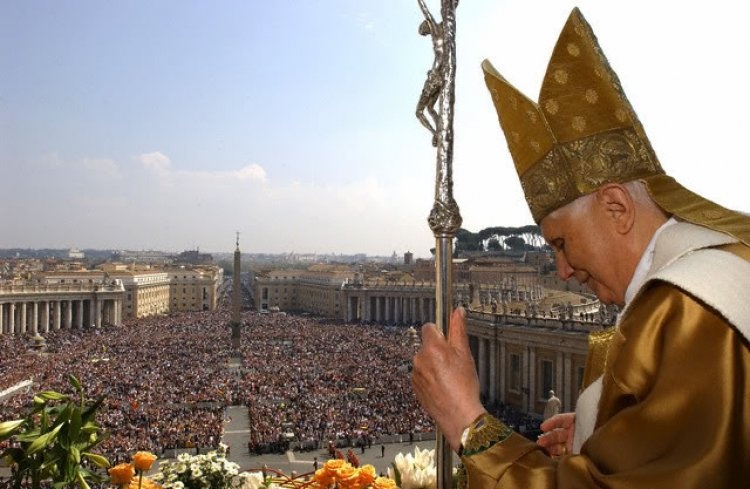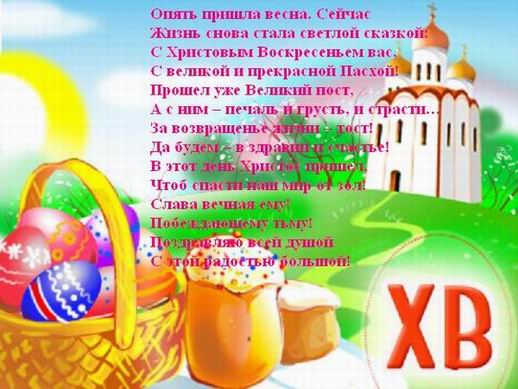Why Easter does not have an exact date. Church Life: Easter Etiquette
0 0Martha Ogirok,
If our grandmothers clearly understood when the Bright Resurrection will be celebrated, then we will know about it from the Internet. And we are very surprised why Christmas, the Annunciation, the Savior are celebrated every year on the same day, and the day of the celebration of Easter changes every year. Why does it depend and how to calculate it?
Why we celebrate Easter on different days

There is a long and common rule for all religions: Easter is celebrated on the first Sunday after the first full moon. And the first full moon follows the day of the vernal equinox - March 22.
IMPORTANT.There are two exceptions to the unified rule for the celebration of Bright Sunday:
The first full moon falls on Sunday - Easter is transferred to the next;
. Christian Easter is not celebrated on the same day as Judaism.

We are guided by the lunar calendar, which is 354 days (in the sunny - 365 or 366 days, if the year is a leap year). It is also important to understand that the lunar month consists of 29.5 days, so the full moon occurs every 29 days.
It turns out that the first full moon after the day of the spring equinox (March 21) comes on different days, so the date of the celebration of Easter is shifted.
IMPORTANT. Since the day of the spring equinox comes on the night of March 21-22, Easter is celebrated no earlier than April 4 and no later than May 8.
Determining the date of the celebration of Easter by the formula

This simple formula was proposed by Karl Gauss in the early 19th century:
1. The year (its number), in which you need to know the date of the Great Day is divided by 19. Balance = A
2. Number of year divided by 4 = B
3. The number of the year divided by 7 = C
4. (19 * A + 15): 30 = number, and the remainder = D
5. (2 * B + 4 * C + 6 * D + 6): 7 = number. Balance = E
6. D + E<= 9, то Пасха будет в марте + 22 дня, если >, then in April: the resulting number - 9
Why Easter is celebrated on different days in different faiths

It has long been a call to celebrate the Catholic and Orthodox Easter on the same day, because these churches produce chronology on different calendars (Orthodox - in Julian, and Catholics - in Gregorian).
In 2017 - an exception, and we celebrate Easter on the same day - April 16. And here is how it will be in 2018 and beyond.
Orthodox Easter 2017 - April 16
Catholic Easter 2017 - April 16
Orthodox Easter 2018 - April 8
Catholic Easter 2018 - April 1
Orthodox Easter 2019 - April 28
Catholic Easter 2019 - April 21
Orthodox Easter 2020 - April 19
Catholic Easter 2020 - April 12
Orthodox Easter 2021 - May 2
Catholic Easter 2021 - April 4
Orthodox Easter 2022 - April 24
Catholic Easter 2022 - April 17
Orthodox Easter 2023 - April 16
Catholic Easter 2023 - April 9
Orthodox Easter 2024 - May 5
Catholic Easter 2024 - March 31
Orthodox Easter 2025 - April 20
Catholic Easter 2025 - April 20
The reason for this difference goes back to the far 325th year, when the First Ecumenical Council decided the rule for calculating the day of Easter: in Rome (for Catholics) - the spring equinox on March 18, in Alexandria (Orthodox) - on March 21.
IMPORTANT.With the Jewish Easter (Pesach), everything is much simpler: it always comes every year on the 15th day of the month of Nisan. This is the date of the exodus of the Jews from Egypt, and the beginning of the month in the lunar calendar of the Jews is the new moon, the lunar month lasts for 28 days.
Happy Easter !!
Bell spring bells,
And the hopes in us woke up again.
Easter is the feast of the Resurrection.
May Faith and Love be resurrected!
About the date of Easter
Probably many of us asked ourselves this question:
Catholic Easter this year was March 31, and the Orthodox - May 5. Why such a discrepancy, more than a month?
To understand this, you need to remember the history of the calculation of the date of Easter.
The question of a single day of celebration of Easter for the whole of Christendom, he was appointed by Emperor Constantine the Great at the Council of Bishops convened in 325 in Nicea, later called the First Ecumenical. At the cathedral, it was decided to coordinate the day of the celebration of Easter.
The main rule for the calculation is:
"Easter is celebrated on the first Sunday after the spring full moon." The spring full moon is the first full moon that comes after the vernal equinox.
In Alexandriatables were created - Easter calendar or Paschaliato determine the date of Easter. They were based on the 19-year lunar-solar cycle, and for the date of the vernal equinox 21 March.
Alexandria Easter used throughout the Christian world until the end of the XVI century.
But in 1582 in the Roman Catholic Church, Pope Gregory XIII introduced new easter andnew calendar (designed by a Jesuit priest and astronomer Christopher Clavius).
The Eastern patriarchs did not accept, betrayed the anathema, and the Gregorian calendar and the new Paschal.
The reason for the adoption of the new calendar instead of the Julian was the shift in relation to the Julian calendar of the vernal equinox, which determined the date of Easter, and mismatch of the easter full moon with astronomical(The date of the equinox shifted to March 10).
Gregorian calendar was introduced in the Catholic countries on October 4, 1582 to replace the old Julian: the next day after Thursday, October 4 was Friday, October 15.
In Russia, the Gregorian calendar was introduced only by a decree of January 26, 1918 of the Council of People's Commissars, according to which in 1918 after January 31 was followed on February 14. Orthodox Church adheres julian calendar.
So, starting in 1583, catholic church uses gregorian easterthe day of equinox for calculations March 21, Gregorian calendar as well orthodox Church adheres to Alexandrian paschalia with March 21, Julian calendar (April 3) ...
Wherein under the full moon and equinox are understood not astronomical phenomena, but calculated dates.
As a result of the reform of Easter, the Catholic Easter is sometimes celebrated earlier than the Jewish or on the same day, and some years ahead of Orthodox Easter by more than a month.
Orthodox Easter date
Orthodox Eastercalculated by Alexandria Paschalia with 21 Marchin Juliancalendar ( April 3).
Date of the first day of Eastermay fall on any of the days from March 22 to April 25according to the Julian calendar (corresponds to the period from April 4 to May 8in Gregorian calendar).
If the full moon is earlier than March 21, then the next full moon (+ 30 days) is considered Easter.
In this, 2013first full moon - March 27 year 2013.
First Sunday after full moon - March 31, then it was Catholic Easter. According to the Orthodox calendar, the spring equinox comes from April, 4 in a new style.
In 2013, the spring full moon 25th of April (in the new style), the nearest Sunday after it on April 28. And here is the stumbling block: the calculation of the date of the Jewish Passover is not carried out in the same way as the modern Israelis do, and again according to the Alexandrian Easter of the 4th century and falls on April 30 (new style). Therefore, the date of Easter is shifted by another week, to be later Easter Jewish ...
And so it was the date of Easter, May 5th.

The cloth is white, a candle,
The flavor of the cake,
Cagor pours into glasses.
Drinking a little - persuasion.
The color of eggs
And smiles of bright faces.
Happy holiday!
Christ is risen!
Kindness, love, miracles!
.
A source
Easter is a wonderful spring holiday. All Christians celebrate it. But for many it remains a mystery the reason for changing the date of the celebration of the great Resurrection.
Reason for changing the date of Easter
Easter is the main challenge of the church calendar. Many people associate changing the date of the holiday with Christmas or other religious holidays. But this judgment is wrong.
The reason for the constant change of date is rooted in the history of the ancient Jews. The moment of the resurrection of Christ coincided with the ancient Jewish holidays - the Jewish Passover (Passover). On this day, the Jews celebrate the exodus from Egypt. This date they have fixed and does not change. It falls on the 14th day of the Aviv Jewish calendar month. On this day, the first full moon always occurs after the vernal equinox. According to the Julian calendar (it was used during the life of Christ), the equinox was on March 21. And since the number of days in these calendars was different, the Easter holiday became passing and is celebrated depending on the full moon following the day of the spring equinox.
How to calculate the date of Easter
Independent calculation of the date of Easter is quite troublesome. To do this, you need the knowledge of the lunar calendar.
The Resurrection of Christ is celebrated on the first Sunday after the full moon, immediately following the vernal equinox. This can be any day from April 4th and ending May 9th. And the number of options for the day of the celebration is 532. That is, all possible options take 532 years. This period is called the Great Indiction and it is constantly repeated.
In the modern world, programs have been developed specifically for the convenience of calculating the day of the holiday. They have already entered all the necessary data and you need to specify only the year of interest. In addition, you can always buy a calendar showing all Orthodox holidays, including rolling ones.
Why is Catholic and Orthodox Easter different?
The difference between two dates of the same holiday is that Catholics and Orthodox use different calendars. In other words, on March 21 according to the Julian calendar (old style) and according to the Gregorian calendar (new style) will fall on different days. That is why Catholic Easter is usually celebrated a week earlier. But there are rare exceptions, when the bright Resurrection of Catholics and Orthodox coincides
25.04.2016
There are holidays, with the dates of which everything is clear and understandable: New Year, for example, or Christmas. And a hundred years ago, and a century ahead, we will celebrate them at a specific time. But for some reason, Easter is celebrated every year on different days and stands out from the slender ranks. What is the cause of this phenomenon? It turns out that Easter is “tied” not to the solar, but to the lunar calendar.
The first spring full moon follows the day of the vernal equinox, and Easter should be celebrated on the first Sunday day after the full moon. The lunar calendar is slightly different than the solar one. So, the “lunar year” lasts only 354 days, and the periods of the full moon come every 29 days. Naturally, every year the first full moon will fall on different dates. Usually, the equinox falls on March 21, so Easter cannot come to us earlier than April 4, just as it cannot stay longer than May 8.
The celebration of Easter has ancient traditions, initially associated not with the resurrection of Christ, but with some customs, rituals that existed among pastoralists and farmers. Then the Jews began to celebrate their Passover, thus fixing in the memory of the people's day the liberation of the Jews from the rule of Egypt. This Easter was widely celebrated on the night of the 14th to the 15th day of the first lunar month. It was the custom to offer sacrifice in honor of the event: to slaughter and cook a young lamb (lamb), which the family ate entirely.
Later, the concept of Easter in the world changed. The beginning of change was laid by Christ. At the Last Supper, he predicted that he would be sacrificed to people, that he was destined to suffer a terrible execution. He seemed to replace the sacrificial lamb in the minds of the people. During the period of the first full moon, Christ was crucified, and on the third day after the tragedy he was resurrected. This day was called Sunday, and since then Easter has been celebrated on the first Sunday following the first spring full moon.
Interestingly, the church lately, feeling the inconvenience of such a “floating” date, makes attempts to secure Easter for any particular day so that Christians around the world celebrate a great holiday together at the same time. Thus, in 1997, at the World Council of Churches Summit, a proposal was made to secure Easter on the second Sunday of April. The Orthodox world had to prepare for the reform scheduled for 2001. However, it was not possible to reach consensus on this issue, and Easter is still celebrated on different days every year.
Perhaps this is right: there are ancient traditions, the change of which requires long and painstaking work with the consciousness of people. It is not excluded a complete rejection of the new and even protest. It may be better to leave it as it is. Let people know that in our constantly oscillating, unstable world there is still something reliable that has been and always will be. And may we continue to celebrate Easter on different spring days every year. The essence of the bright joyful holiday does not change.
P
asha is the main holiday of all Orthodox Christians and Catholics. There is nothing more important for a true believer than the day of the Resurrection of the Lord. No other joy can be enjoyed by an Orthodox or a Catholic than the remembrance that Christ atoned for sins. After all, this made it possible to inherit the kingdom of heaven. On the day before Easter, the Sabbath, Christ descended into hell and set free all who had previously sat there.
Certainly an important holiday for all Christians. But the dates of its celebration differ significantly depending on the denomination. Catholics celebrate Easter usually earlier than the Orthodox. In particular, this is due to another system of chronology. They have more complex rules for calculating the date of celebration of this day. Among Orthodox Christians, Easter can be celebrated both later by Catholics and on the same day. Why is it so complicated? Is it not possible to just celebrate in one day? There are motives for this that are shown in the Bible.
When is Easter celebrated?
This holiday is always celebrated on the same day of the week - Resurrection. Actually, this name comes from the expression “Little Easter”, which designates the seventh day of the week of our calendar. In a weekly circle of worship every day means something. Thus, the environment symbolizes the betrayal of Judas Jesus Christ, therefore, this day is considered to be fast even during “short-term” periods of time.
The same goes for Friday, when the church remembers the crucifixion of Jesus Christ. Of course, not as detailed as it is during Holy Week. But also essential. But each Resurrection Orthodox and Catholics remember the moment when Jesus Christ became alive again (actually, according to Orthodox dogma, he did not die at all). This happened only with his human nature, while the Divine remained alive.
But after the resurrection, he again had a full-fledged human body. This is evidenced by the way Thomas the unbeliever himself put his fingers into His wounds and became convinced of their authenticity. But the most important of them is only one - it is Easter. Why is it celebrated every time at another time?
Judean and Christian Easter
The Jews also have their own holiday, called exactly so. But it is important to distinguish their essence. In the Jews, Easter is the name of the deliverance by God of this nation from the slavery of Egypt. For Christians, this holiday marks the deliverance of man by God from the slavery of the devil by the resurrection of the Lord Jesus.
Christ Although, of course, in something two Easter similar between themselves. The pattern remained the same.
The main thing after the Resurrection of Jesus is the Christian Easter, not the Hebrew, which was only its prototype. However, there are some differences in the structure of the celebration. Jews celebrate this holiday according to the lunar calendar, not the solar one. The Orthodox use a completely different system for calculating the date of their main holiday. But their calculation of the day of Easter is still tied to the Jewish one.
Freedom from Egyptian slavery is described in the thirteenth chapter of the book “Exodus” in the Old Testament. This event is really important not only for the entire Jewish people, but also for Orthodox countries. It is worth noting that on the eve of Easter chapters from this book are being read very actively, because this event among the Jews is the prototype of the Resurrection of the Lord Jesus Christ. And not only among the Jews. They just still believe in the coming of the Lord, and the Orthodox claim that it happened.
See for yourself on the parallel. Even beforehand, the Lord had warned the Jews that only by killing every firstborn in the family could the liberation of the Jews be achieved from the Egyptians.
He said that they would slaughter the best lamb, and smear their door with blood, so that when the angel passes, he would not touch such a room. And after the murder of all the firstborn, Pharaoh allowed the Jews to leave Egypt and return to their land. And since that time, the Easter lamb is laid every year.
In the same way, the prophets foreshadowed the coming of the Savior of all mankind, who with his blood would atone for the sins of all people and free them from the servitude of the devil, like the lamb who was sacrificed to sacrifice them from the slavery of Egypt. The parallels are very interesting, isn't it?
This lamb becomes the prototype of our Lord, who also with his blood freed the human soul from the devil. Of course, much also depends on us. It all depends on whether he wants to let God in or not. Many deliberately renounce Christ, although he wants to go into the upper room, which is closed to a person in the soul. Because if this desire is not there, the devil takes possession of the soul in the same way as the Jews could voluntarily return to Egyptian slavery. And he will do everything possible so that God does not get into the soul even of himself in the words of a believer. Moreover, as the Jews were crossing the Red Sea, and the Egyptians were catching up with them, the devil is also after us, and we need to hide from him with the help of God.
You can not be cowardly. After all, this quality of the human soul does not give absolutely no opportunity to be saved. You need to have a certain courage to resist the devilish invasion and faith in God to help in this endeavor. After all, he was crucified for our sins. He acts as a Jewish lamb, and this is explicitly written in the Gospel. It is important to understand that the crucifixion on the eve of Jewish Passover is altogether accidental. This is natural.
When was Christ crucified?
According to the Jewish calendar, it was 14 Nisan. That is, in the full moon after the vernal equinox. And three days later he was resurrected. That is why the third day after the crucifixion is called the resurrection. So the Jewish and Orthodox Easter are interconnected. About three centuries of the flow of the history of Christianity were 2 dates at once, when Easter was celebrated. Consequently, the people were divided into 14 Nisan celebrating along with the Jews, and the second group three days after Jesus died as evidence of his Resurrection. But the final date for the celebration of Easter was set at the first Ecumenical Council.
He became the beginning of the formation of a unified Christian liturgical system. Then it was also determined what the basic provisions of this religion and what dogmas to consider the main. Simply put, he was the beginning of explaining to the people what to believe. In particular, at the first ecumenical council, the Symbol of Faith was also proposed, which in a concise and accessible form explained what every Christian should believe. This chant sounds at every liturgy, so that people never forget who they are.
When is Easter celebrated?
At this ecumenical council it was found that it was necessary to celebrate Easter on the first Sunday after the first full moon, which follows the day of the vernal equinox. Such a date is calculated according to a complex formula, and modern technologies make it possible to predict Easter Day for many decades to come.
Julian and Gregorian calendars
In general, after the first ecumenical council, all Christians began to celebrate Easter on the same day. But in 1054 there was a split: the Orthodox and Catholic Christian churches appeared. In the date of the celebration of the Resurrection, nothing has changed. But modifications happened in 1582. Then the Julian calendar, generally accepted at the time, began to be considered not entirely accurate. Therefore, Pope Gregory the 13th in 1582 introduced the Gregorian calendar.
Due to greater astronomical accuracy, most countries still use it. But the Orthodox still use the Julian calendar, despite its nearness, because Christ lived in those times. Although recently there have been active conversations about the transition of all churches to the Gregorian calendar. Where it leads? Yes to positive changes. So, Orthodox and Catholics will celebrate Christmas on December 25th. The fast will end before the New Year and the Orthodox will not break it.
So, this calendar says: The resurrection of the Lord comes immediately after the Jewish Passover, the next day. But according to the Gregorian calendar, Catholic Easter may even be Jewish before. Therefore, the discrepancy in the numbers can be quite significant, since taking into account a different calendar system. Consequently, another day of the vernal equinox. Easter for Catholics may be thirteen or more days earlier. Although the Holy Fire comes down on Easter day according to the Orthodox calendar, not the Catholic one.
New Articles
- What is the highest peak of the Ural Mountains
- The most ancient religions in the world
- What continents are washed by the Atlantic Ocean?
- Can I wear jewelry of the deceased?
- Snake, Bowl and Staff: The Origin of Medical Symbols
- Interesting facts about hares
- Names of famous brands in other countries
- Karelo Finnish epic kalevala protagonists
- 17 18 weeks pregnant sensations
- Why do people become so aggressive
Popular articles
- Expression twice in one river, meaning and meaning
- Gusli - musical instruments
- Report: Temperature Scales and Thermometers
- Which side to sew on chevron
- How to draw emblems for school
- Unusual rivers of the world and the rivers of Russia - Rivers with sour water
- Numb of the little finger on the right hand: causes and methods of treatment
- Why development is important for a person
- Constellations from ancient atlases
- What happens at 31 weeks
